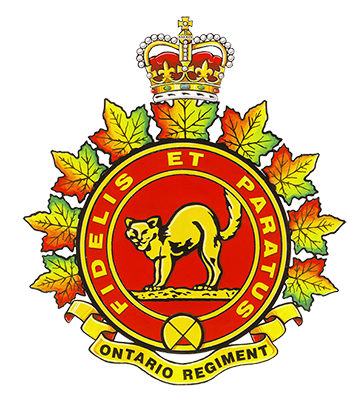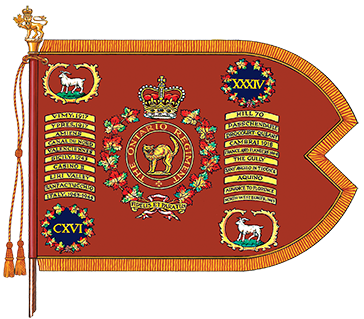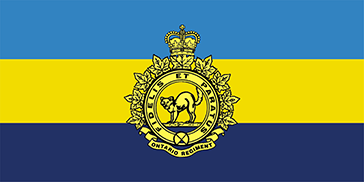The Ontario Regiment (RCAC)
The official lineage of The Ontario Regiment (RCAC) armour regiment.

Badge
Description
Gules on a bar a cat statant guardant irate Or, the whole within an annulus Gules fimbriated and inscribed with the motto FIDELIS ET PARATUS in letters Or and surmounted at the base by a bezant fimbriated and charged with a fillet saltire Sable the base quarter removed, and beneath the annulus a scroll Or with the words ONTARIO REGIMENT inscribed in letters Sable, and above, encircling the annulus, a wreath of nine maple leaves autumnally coloured, the centre one in chief ensigned by the Royal Crown proper.
Symbolism
The badge is based, in part, on the cat from the Clan MacGillivray familial crest, a member of which commanded the regiment in the early 1900s. After the First World War, the cat was redesigned into a fierce or fighting pose echoing the experience of the regiment's members in the war. The maple leaves, nine in total, reflect the nine provinces that contributed soldiers to the First World War battalions which the regiment perpetuates. The three quarters of a disc in the base of the badge represents the old regimental Militia number "34". "ONTARIO REGIMENT" is a form of the regimental title and "FIDELIS ET PARATUS" is the motto of the regiment.
Motto
FIDELIS ET PARATUS (Faithful and ready)
March
John Peel
Alliance
British Army
The Royal Regiment of Wales (24th/41st Foot) The Royal Welsh
Guidon

Camp flag

Battle honours
The First World War
SOMME, 1916; ARRAS, 1917, '18; Vimy, 1917; HILL 70; YPRES, 1917; Passchendaele; AMIENS; Scarpe, 1918; Drocourt-Quéant; HINDENBURG LINE; Canal du Nord; Cambrai, 1918; VALENCIENNES; FRANCE AND FLANDERS, 1916-18.
The Second World War
Pursuit to Messina; SICILY, 1943; Colle d'Anchise; The Gully; Casa Berardi; Ortona; Point 59; CASSINO II; Gustav Line; Sant'Angelo in Teodice; LIRI VALLEY; Aquino; TRASIMENE LINE; Sanfatucchio; AREZZO; ADVANCE TO FLORENCE; ITALY, 1943-1945; Arnhem, 1945; NORTH-WEST EUROPE, 1945.
South-West Asia
AFGHANISTAN
Lineage
This Reserve Force regiment originated in Whitby, Ontario on 14 September 1866, when the '34th "Ontario Battalion of Infantry"' was authorized to be formed.Footnote 1 It was redesignated: '34th Ontario Regiment' on 8 May 1900;Footnote 2 'The Ontario Regiment' on 1 May 1920;Footnote 3 'The Ontario Regiment (Tank)' on 15 December 1936;Footnote 4 and '2nd Regiment, The Ontario Regiment (Tank)' on 13 August 1940.Footnote 5 It was converted to armour and redesignated: '11th (Reserve) Army Tank Battalion, (The Ontario Regiment (Tank))' on 1 April 1941;Footnote 6 '11th (Reserve) Army Tank Regiment (Ontario Regiment (Tank))' on 15 August 1942;Footnote 7 '11th Armoured Regiment (Ontario Regiment), RCAC' on 1 April 1946;Footnote 8 'The Ontario Regiment (11th Armoured Regiment)' on 4 February 1949;Footnote 9 and 'The Ontario Regiment (RCAC)' on 19 May 1958.Footnote 10
Notes:
Upon redesignation as The Ontario Regiment on 1 May 1920 (see above), it was organized as a two battalion regiment with the 1st Battalion (116th Battalion, CEF) on the Non Permanent Active Militia order of battle, and the 2nd Battalion (182nd Battalion, CEF) on the Reserve order of battle. The reserve unit was disbanded on 14 December 1936 (GO 3/37).
The Ontario Regiment was disbanded for the purpose of reorganization on 1 November 1920 and reorganized the same day (GO 80/21). This change was administrative and does not affect the lineage of the regiment.
The Ontario Regiment was disbanded for the purpose of reorganization on 14 December 1936 and reorganized the next day (GO 188/36). This change was administrative and does not affect the lineage of the regiment.
Perpetuations
'116th', and '182nd "Overseas" Battalion(s), CEF'
Headquarters Location
Oshawa, Ontario
Operational history
The First World War
The 116th Battalion, which was authorized on 22 December 1915 as the '116th "Overseas" Battalion, CEF',Footnote 11 embarked for Britain on 24 July 1916.Footnote 12 From October to December 1916 it provided reinforcements for the Canadian Corps in the field, and on 11 February 1917 it disembarked in France,Footnote 13 where it fought with the 9th Infantry Brigade, 3rd Canadian Division in France and Flanders until the end of the war.Footnote 14 The battalion was disbanded on 30 August 1920.Footnote 15
The 182nd Battalion, which was authorized on 15 July 1916 as the '182nd "Overseas" Battalion, CEF',Footnote 16 embarked for Britain on 3 May 1917.Footnote 17 Its personnel were absorbed by the '18th Reserve Battalion, CEF' on 16 May 1917 to provide reinforcements for the Canadian Corps in the field.Footnote 18 The battalion was disbanded on 1 September 1917.Footnote 19
The Second World War
The regiment mobilized the 'The Ontario Regiment (Tank), CASF' for active service on 1 September 1939.Footnote 20 It was redesignated: 'The Ontario Regiment (Tank), CASF' on 13 August 1940.Footnote 21 It was converted to armour on 23 November 1940,Footnote 22 and an army tank battalion on 11 February 1941, under the designation '11th Army Tank Battalion (The Ontario Regiment (Tank)), CAC, CASF'.Footnote 23 It was redesignated: '11th Army Tank Regiment (The Ontario Regiment (Tank)), CAC, CASF' on 15 May 1942;Footnote 24 '11th Armoured Regiment (The Ontario Regiment), CAC, CASF' on 26 August 1943;Footnote 25 and '11th Armoured Regiment (The Ontario Regiment), RCAC, CASF' on 2 August 1945.Footnote 26 On 21 June 1941 it embarked for Britain.Footnote 27 The regiment landed in Sicily on 13 July 1943, as part of the 1st Canadian Armoured Brigade, and in Italy on 3 September 1943 in support of 17th Brigade, 5th British Division.Footnote 28 On 8 March 1945 the regiment moved with the 1st Canadian Corps to North-West Europe, where it fought until the end of the war.Footnote 29 The overseas regiment was disbanded on 15 December 1945.Footnote 30
South-West Asia
From 2002 to 2014, The Ontario Regiment (RCAC) reinforced various CAF units deployed to Afghanistan.Footnote 31